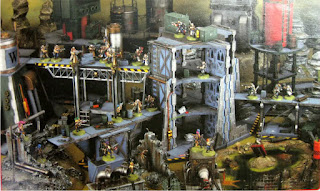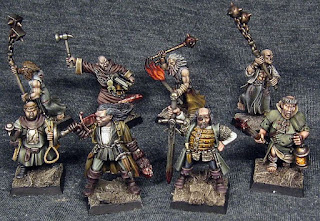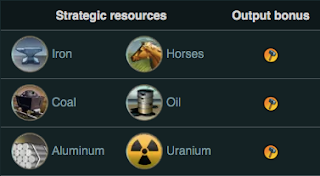So in this post I will talk about the games that either inspired me on a gameplay level, or games that I used mechanical ideas from. Some will be obvious, some a little more obscure.
First up, the most obvious ones.
Necromunda/Mordheim
 In all honesty, their would likely be no Radlandz without these two games. They were the original "warband" level games that I played and their influence can be seen throughout.
In all honesty, their would likely be no Radlandz without these two games. They were the original "warband" level games that I played and their influence can be seen throughout. Core concepts like group size, rosters, character types, loot, experience, skill upgrade and territory all find their origins here
 The core gameplay mechanics are very different, but the overall feel is similiar. But I really wanted to make a few changes in the overall feel to "fix" what i perceived to be problems with the games.
The core gameplay mechanics are very different, but the overall feel is similiar. But I really wanted to make a few changes in the overall feel to "fix" what i perceived to be problems with the games. The two core issues are randomness and loss. Random skill increases always led to big skews in power between gangs, so instead I allow people to select them from a short list.
Loss was a huge deal in these games. If you played your first game with a gang and your heavy died, taking almost a 3rd of your gang value with him, you were actually better off rolling up a new gang. In Radlandz, your group will never drop below a minimum level of functionality. New troops are free and they come with their basic kit, they just have no XP or special upgrades. So even if your entire group is killed in the first game, you don't need to reroll.
Frostgrave
"A dog made me build Radlandz"
Frostgrave is the game that kicked off the whole process. I really really wanted to like it, but I found the randomness and lack of distinction in the forces frustrating.
In the game we play, a war dog ate most of my army. Single handily killing 4 characters, a man at arms, an infantry man and two thugs. I rolled no less than a 13 on all 4 combats, but the war dogs player always rolled higher. The difference between a -1 rating war dog at 10 points and a +1 rating Man at arms at 80 points is negligible in a d20 system. I felt the game was pretty damned arbitrary at that point and that units really didn't matter much.
But I saw potential in the game, but figured it needs many house rules to make work. The randomness was too swingy for me, the spell lists full of chaff, the XP system skewed heavily in favour of combat mages, and the cost of losing your wizard was brutal.
What I really liked were the turn order sequence and the idea that Wizards had spells outside their primary disciplines. I've adapted the turn order sequence and am using something similar, and the wizard selection thing has become the "identity system", where a group has a primary identity it can buy characters from, but can also pick up secondary identities and populate their list with skills and troops from there.
A Mutant identity group fields mutants as their primary forces, but if they get some points in the Arcane identity, they may pick up an apprentice spell caster and some magic skills. Hopefully, with 12 identities, this means that there are a plethora of combinations and no group looks completely like another.
Spartacus - A game of blood and sand
Spartacus was one of the most surprising games I've played. It a really good design, true to the source material, and a great backstabbing fun fest.
The gladiatorial combat system is fun and simple, and represents wounded characters losing fighting capacity really well.
I borrowed a lot of elements from the combat system for the melee system of Radlandz.
Each player rolls their melee pool of dice, then modifies them with parry re-rolls, shields and other tricks. Then they match numbers on their dice from highest to lowest. The more dice you win on the matchup, the more damage you inflict. Tie and you both inflict damage. Strong melee characters are normally either more dice or bigger dice, so will win more often. Wounds reduce the size of your dice in the dice pool.
What this has mean't in testing is that well trained unwounded soldiers tend to butcher wounded ones easily, but not always. Poor quality troops have taken down melee masters as well, one expert melee character was taken down by a group of 4 guys with knives, as each one got a small hit in, reducing the big guys combat skills and making him easier to wound. Gang ups really work well.
It's also led to two already wounded characters killing each other in combat as they both score enough hits to do a killing blow to each other.
The gladiatorial combat system is fun and simple, and represents wounded characters losing fighting capacity really well.
I borrowed a lot of elements from the combat system for the melee system of Radlandz.
Each player rolls their melee pool of dice, then modifies them with parry re-rolls, shields and other tricks. Then they match numbers on their dice from highest to lowest. The more dice you win on the matchup, the more damage you inflict. Tie and you both inflict damage. Strong melee characters are normally either more dice or bigger dice, so will win more often. Wounds reduce the size of your dice in the dice pool.
What this has mean't in testing is that well trained unwounded soldiers tend to butcher wounded ones easily, but not always. Poor quality troops have taken down melee masters as well, one expert melee character was taken down by a group of 4 guys with knives, as each one got a small hit in, reducing the big guys combat skills and making him easier to wound. Gang ups really work well.
It's also led to two already wounded characters killing each other in combat as they both score enough hits to do a killing blow to each other.
The overall result is a rather cinematic combat system that has already produced numerous classic and memorable moments.
Melee is the key to the game, shooting is designed to pin people and wound them, making them easier to mop up in close combat.
Fortress America
Fortress america is an inspiration for the dice shifting mechanic in Radlandz. In fortress america, better units roll a higher sided dice which has a better chance of hitting and doing damage. Defending can shift a units dice up by one improving their chances of hitting and damaging.
In Radlandz I use a similar system. Each model has it's default dice pools for making ranged, melee, and morale checks. But these pools can be modified up and down depending on the models state. For example, Aiming and Charging allow you increase a dice by one size, each wound level reduces a dice by one size.
The core difficulties to pass most checks are designed around the difficulty required for a d8 to succeed. So having upgraded dice to d10's improves that considerably, without altering the difficulty of the roll. In a way, it allows for more marginal alterations of difficulty than changing a target number, especially in a multiple dice system.
All dice are discrete, so if the target number for a roll is 6, and you roll 8, 6, 4. You score two hits, dice are never added together in Radlandz.
Dice can go all the way up to a D12, but never below a D6.
X-wing
A really simple one here, D8's
Looking at X-wing over the last few years I have really gotten to appreciate the D8 in regards to probability. 12.5% per pip is really easy to work with, as a shift in difficulty by one is significant, but not huge.
Also, the core concept of rolling a number of d8's and marking the number of hits scored is directly linked to X-wing in its original form.
With dice shifting and the like it's now quite different, but the ranged combat system started off with x-wing as the inspiration.
 Flames of war
Flames of war
I've never actually played Flames of War, which seems odd as I know a lot of one of the oldest playtest groups for the game (who I am hoping to co-opt into testing this), i'm a military history nerd, and I own the rule book.I just never got around to it.
The one thing I did love reading the rules was the idea that the difficulty to hit a solider with a ranged attack is based on their training level. Conscripts use cover poorly, Veterans hug the dirt like its a long lost teddy bear.
In Radlandz, the difficulty to hit a model is based on their Brainz stat. Smart and savvy characters take cover quickly, poorly trained troops do not. As characters get more experienced, they become harder to hit. Also, big dumb killer robots are easy to hit, even if they are hard to damage.
It's a simple concept, but one I had not seen before Flames of War.
Cthulhu wars
This is an example of how a mechanic in a game can inspire you to make a game design decision, that if you didn't spell it out clearly, no one would probably notice.In Cthulhu wars, each faction has six spell books that are unlocked as complete objectives. You don't get all your powers and abilities at the game start and must do stuff to get them.
This system inspired the base system in Radlandz. Bases determine what models you can field and how many skills are on your available skill list.
At the start of the campaign, you may only have access to 3 or 4 skills, and 3-4 unit types. But as you progress, you can expand the base and gain more skills to choose from, more unit types to field, and more equipment options from resources.





